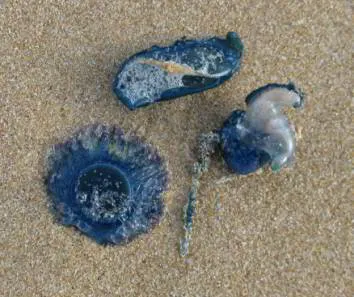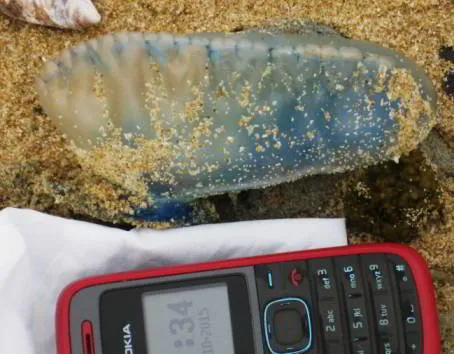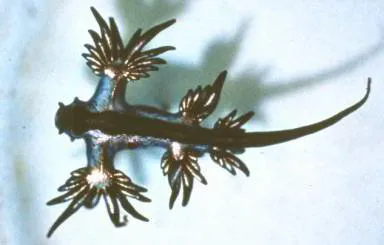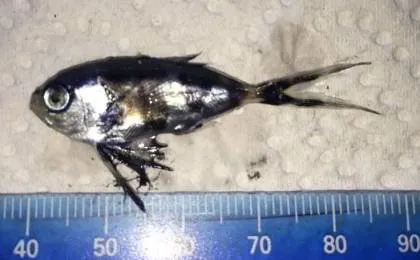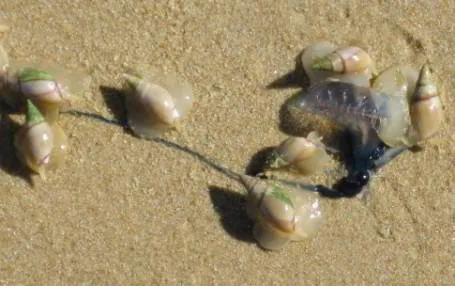Everyone knows Africa’s “Big Five”, some might even know of the “Famous Five”, but have you heard of the “Blue Five”? No? Not surprising as it’s my personal name for the group of five invertebrate marine creatures that are often washed ashore on our beaches
The “Blue Five” are pelagic (open ocean), surface-dwelling, blue-coloured creatures the most notorious of which is the ‘Portuguese-man-o-War’ or ‘bluebottle’,Physalia physalis of the Atlantic Ocean or Physalia utriculus of the Indo-Pacific Oceans[1]’; one of three colonial hydrozoans; siphonophores. The other two in this scary blue trio are Velella velella, the by-the-wind-sailor, and Porpita porpita, the ‘blue button’. All three appear to be single organisms but are really an assemblage of many individuals each having a specific function – such as stinging, feeding, reproduction etc. – but working together as a single unit.
Do they all sting? Well, yes, they all have stinging cells called nematocysts but only the sting of Physalia affects humans[2]. A nematocyst is a tiny sac-like cell containing venom, a coiled invovlute barbed ‘harpoon’ and an external trigger hair. Contact with the trigger hair fires the harpoon and the cell contract forcing the venom into its victim.
Top: Velella velella, Right: Physalia utriculus, Left: Porpita porpita. Photographed in Cannon Rocks November 2011.
Left: Velella showing the ‘sail’, Right: Velella fleet invasion of Cannon Rocks!
A very large Physalia on the beach at Cannon Rocks November 2015
That’s three of the “Blue Five”. So what are the other two? For a start they are very different from the previous trio; they are not siphonophores. One is a true gastropod mollusc, the other is a nudibranch, an opistobranch (sea slugs) mollusc.
Janthina janthina and J. prolongata are two of the most common ‘blue snails’ one is likely to find on our beaches though the latter is relatively rare. These snails move actively through the water column when young but as adults they float suspended by a bubble raft to which they also attach their eggs. The shells are very delicate and often broken when washed ashore. So what makes them a member of the “Blue Five”? Not just their colour, though they are blue. They are true, active members of the group because they live amongst, and feed on, the ‘blue trio’. Yes, they are bluebottle predators!
Janthina janthina above, J. prolongata below. Cannon Rocks 22 November 2015.
The fifth member of our group is a truly remarkable and beautiful creature. Not often recognised because when washed ashore it soon becomes an amorphous blue/white glob. This little fellow is an opisthobranch mollusc (sea slug!), a nudibranch and another voracious predator of the ‘blue trio’. Its popular name is ‘sea swallow’ but in formal address is Glaucus atlanticus.
Glaucus spends its life upside down buoyed by a small gas bubble in their stomach. The beautiful blue and silver/white pattern we see is actually the creature’s underside – its dorsal surface is silver grey to white. This is a typical example of colour countershading. Their foot and undersides of the cerata is blue or blue and white, which helps to camouflage them from predation from above. Their true dorsal surface, which faces down in the water, effectively camouflages them from fish looking up from below.
And that’s not all that makes these little creatures unique. The nudibranch feeds almost exclusively on Physalia, and it appears that they are able to select the most venomous of Physalia’s stinging cells (nematocysts) for their own defence. Like most aeolid nudibranchs, they store the nematocysts in special sacs (cnidosacs) at the tip of their cerata. They can and do sting. However, I personally have handled many specimens, moribund and alive, and have never experienced any sting.
Left: The underside of a moribund Glaucus. Right: The Dorsal side of a moribund Glaucus. Beach stranded specimens photographed at Cannon Rocks.
Glaucus atlanticus. Aquarium specimen collected at Coffee Bay.
We cannot leave the “Blue Five” without mention of another wannabe member of the group, though one that is morphologically very different from all the above! The original “Blue Five” are all invertebrates – this little chap is a vertebrate: a fish that feeds on Physalia tentacles and gonads.
Known as the man-of-war fish or bluebottle fish, Nomeus gronovii, is a driftfish with a circum-tropical distribution. The young live near the ocean surface among stinging tentacles Physalia ‘rafts’ and, while claiming some degree of protection from predators, exchanges this for enticing potential prey into Physalia’s stinging barbs. Adults live in deeper water reaching a length of almost 40cm. Unlike clownfish that use mucus to prevent the discharge of stinging nematocysts from their host anemone, Nomeus appears to rely on agile swimming to physically avoid being stung.
Juvenile Nomeus gronovii. Beached specimen at Cannon Rocks. Zenobia Monro photo.
Perhaps we should include this fellow in our “Blue Five”, and call them the “Blue Five-and-a-half”? Call in the disposal squad!! Bullia rhodostoma (plough shells) feasting on a Physalia utriculus. Boknes. February 2015
P. physalis has multiple stinging tentacles, a potent venom, and attains a size double that of P. utriculus which has only a single stinging tentacle. The ones we usually find at Cannon Rocks after strong Easterly storm winds are P. utriculus.
Physalia stings can be life-threatening to those who are hyper-sensitive to the venom, or if the stinging tentacle gets wrapped around one’s torso, head or neck. The victim must be immediately removed from the sea and adhering stinging tentacle removed with a dry cloth or towel. Pieces of tentacle can be washed away with sea water (never fresh water as this triggers the discharge of more stinging cells). Remaining adherent stinging cells should be scraped away using the back of a knife or even a credit card. Current thought on alleviating the pain is to avoid alcohol, vinegar or ammonia (do people really take this stuff to the beach?), and urine has no affect at all other then a possible psychological one! Bathe the affected areas with hot water; water as hot as can be tolerated without causing further damage. The heat denatures the venom’s protein component. For further information see:https://en.wikipedia.org/wiki/Portuguese_man_o%27_war
Article written by: Robin Stobbs
Featured image: Portuguese Man O’ War by Matthew Smith (Via The Atlantic here)
